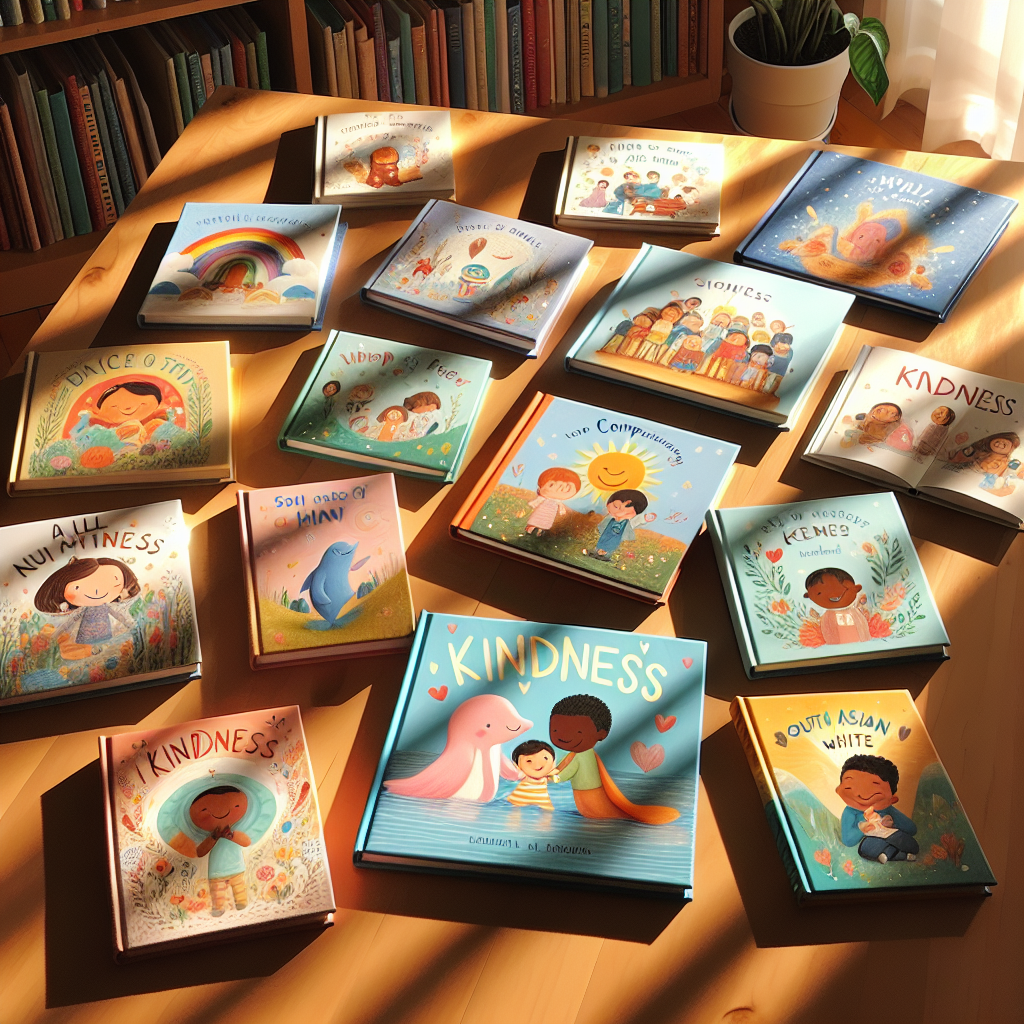So, you love children’s books, huh? Well, get ready to embark on a heartwarming journey with “The Kindness Club: A Collection of Children’s Books.” This delightful compilation is all about spreading love, compassion, and empathy to our little ones. With captivating stories and colorful illustrations that will surely capture their imaginations, these books are not only entertaining but also teach invaluable life lessons. Whether it’s a story about sharing, helping others, or being kind to animals, “The Kindness Club” has it all. Get ready to inspire and nurture kindness in the hearts of the young ones with this enchanting collection.

This image is property of images.pexels.com.
1. The Importance of Teaching Kindness
Teaching kindness is a vital aspect of a child’s development. By instilling the value of kindness at an early age, we can shape children into compassionate and empathetic individuals who make positive contributions to society. There are several key areas where teaching kindness plays a crucial role.
1.1 Teaching Empathy
Empathy is the ability to understand and share the feelings of others. By teaching empathy, children learn to recognize and validate the emotions of those around them. This helps them form stronger connections with their peers and fosters a sense of compassion and understanding. Through activities and discussions centered around empathy, children can develop the skills needed to navigate relationships and respond to the needs of others.
1.2 Fostering Positive Relationships
Kindness is the foundation of positive relationships. When children practice kindness, they are more likely to be accepted and valued by their peers. They learn to work collaboratively, support one another, and resolve conflicts peacefully. By fostering positive relationships, children not only experience a sense of belonging but also develop important social skills that will benefit them throughout their lives.
1.3 Developing Emotional Intelligence
Emotional intelligence refers to the ability to identify and manage one’s own emotions and the emotions of others. Teaching kindness helps children develop emotional intelligence by encouraging them to consider the effects of their behavior on others. When children understand the impact of their actions, they become more self-aware and better equipped to regulate their emotions. This leads to healthier relationships, improved communication, and enhanced overall emotional well-being.
2. Incorporating Kindness into Children’s Literature
Children’s literature plays a fundamental role in shaping children’s values and beliefs. By incorporating kindness into books, authors have the opportunity to inspire young readers to embrace this virtue. There are several ways in which kindness can be integrated into children’s literature.
2.1 Themes of Kindness
Authors can explore various themes of kindness, such as acts of generosity, empathy, inclusivity, and forgiveness. By incorporating these themes into their stories, authors provide children with valuable life lessons and inspire them to practice kindness in their own lives.
2.2 Characters Promoting Kindness
Creating characters that embody kindness allows children to relate to and empathize with the protagonists. Characters who consistently demonstrate kindness serve as positive role models and encourage children to emulate their behavior.
2.3 Impact of Kindness on Plot Development
Kindness can also play a pivotal role in driving the plot of a children’s book. Whether it’s a story about a character overcoming adversity through acts of kindness or a tale that highlights the transformative power of empathy, the inclusion of kindness in the plot can engage young readers and leave a lasting impact.

This image is property of images.pexels.com.
3. Notable Children’s Books on Kindness
There are numerous children’s books that beautifully capture the essence of kindness. These books not only entertain but also educate and inspire young readers to embrace the value of kindness. Here are three notable titles that stand out:
3.1 Title A: Kindness Starts with Me
“Kindness Starts with Me” is a heartwarming story that follows the journey of a young girl named Lily who discovers the power of kindness in her everyday life. Through relatable situations and endearing illustrations, this book teaches children the simple yet profound impact of small acts of kindness.
3.2 Title B: The Power of Friendship
“The Power of Friendship” tells the tale of two unlikely friends, Sam and Mia, who overcome obstacles by relying on the strength of their friendship. This book emphasizes the importance of kindness in building and maintaining strong relationships, showing children that kindness plays a significant role in nurturing friendships.
3.3 Title C: A World of Kindness
“A World of Kindness” takes young readers on a journey around the globe, exploring different cultures and illustrating the universal language of kindness. Through vibrant illustrations and engaging storytelling, this book instills in children a sense of empathy and celebrates the power of kindness to bridge cultural divides.
4. Teaching Kindness through Storytelling
Storytelling is a powerful tool for teaching kindness to children. By using books as a starting point, parents and educators can facilitate meaningful discussions and impart valuable lessons. Here’s how storytelling can effectively teach kindness:
4.1 Promoting Discussion
After reading a book that highlights kindness, it is important to engage children in post-story discussions. Encourage them to share their thoughts, emotions, and personal experiences related to the themes and characters in the book. By discussing kindness, children deepen their understanding and internalize its importance.
4.2 Encouraging Empathetic Responses
Storytelling allows children to step into the shoes of the characters and see situations from different perspectives. Encourage children to imagine how the characters might be feeling and think about possible reasons behind their behavior. This encourages empathy and helps children develop a greater sense of understanding and compassion.
4.3 Lessons in Compassion and Understanding
Through carefully selected books, children can learn important lessons about compassion and understanding. Stories that portray characters dealing with challenges, conflicts, or difficult emotions provide opportunities for children to explore these concepts and discover how kindness can make a positive difference.

This image is property of images.pexels.com.
5. Benefits of Reading Children’s Books on Kindness
Reading children’s books that emphasize kindness offers a multitude of benefits for both children and their caregivers. Here are some key advantages:
5.1 Building a Foundation for Kindness
By immersing children in stories that promote kindness, we lay a strong foundation for their moral development. Regular exposure to books that emphasize kind behavior helps children internalize this virtue and make it a part of their identity.
5.2 Developing Moral Values
Children’s books on kindness serve as an effective tool for instilling important moral values. By witnessing characters engage in acts of kindness, children learn virtues such as empathy, compassion, and respect, fostering their moral growth and guiding their actions.
5.3 Enhancing Emotional Wellbeing
Reading children’s books on kindness can have a positive impact on a child’s emotional well-being. These stories often evoke feelings of joy, warmth, and understanding, which contribute to a child’s overall emotional health. Furthermore, when children witness acts of kindness, they experience a sense of fulfillment and purpose, which boosts their self-esteem and promotes a positive outlook on life.
6. Implementing The Kindness Club in Schools and Communities
To further create a culture of kindness, schools and communities can establish The Kindness Club. This club can serve as a platform for children to engage in activities and initiatives that promote kindness and empathy. Here’s how The Kindness Club can be implemented:
6.1 Establishing The Kindness Club
Gather a group of enthusiastic students, teachers, and community members who are passionate about promoting kindness. Create a mission statement and establish regular meetings to brainstorm ideas and plan kindness-related activities.
6.2 Organizing Book Swaps and Activities
Include book swaps as part of The Kindness Club’s initiatives. Encourage members to donate books on kindness and organize events where children can exchange books, fostering a love for reading and spreading the message of kindness. Additionally, plan activities such as storytelling sessions, arts and crafts projects, or community service projects centered around kindness.
6.3 Encouraging Acts of Kindness
The Kindness Club can launch campaigns to inspire acts of kindness within the school or community. Encourage club members to identify opportunities for small acts of kindness, such as writing kind notes to classmates or helping someone in need. By providing a platform for these acts, The Kindness Club can encourage a culture of kindness and make a positive impact.

7. Parental Involvement in Promoting Kindness
Parents play a vital role in teaching kindness to their children. By actively participating in promoting kindness, parents can reinforce the values learned from reading children’s books. Here’s how parents can get involved:
7.1 Reading Books Aloud
Parents can read children’s books on kindness aloud to their children, providing an opportunity for shared learning and discussion. By modeling the act of reading and engaging in conversations surrounding the themes, parents can further enhance their child’s understanding of kindness.
7.2 Discussing the Importance of Kindness
Engage in conversations about kindness with your child on a regular basis. Discuss what kindness means, why it is important, and how they can incorporate it into their daily lives. Encourage them to share their thoughts and experiences related to acts of kindness, fostering open dialogue and deepening their understanding.
7.3 Modeling Kind Behavior
Lead by example and demonstrate acts of kindness in your own interactions. Children learn by observing their parents, so it is crucial to model kind behavior in day-to-day life. Show appreciation, offer help to others, and practice empathy. By being a role model of kindness, parents can inspire their children to follow suit.
8. The Role of Illustrations in Portraying Kindness
Illustrations in children’s books have a significant impact on how kindness is portrayed and understood. Here’s how illustrations play a crucial role:
8.1 Visual Depictions of Kindness
Illustrations provide visual cues that enhance the reader’s understanding of kind behavior. They bring the characters and their actions to life, allowing children to visualize and connect with the story on a deeper level. Well-executed illustrations can evoke emotions and serve as powerful reminders of the importance of kindness.
8.2 Enhancing Storytelling through Art
Illustrations complement the written text and can enhance the storytelling experience. They can depict facial expressions, body language, and other nonverbal cues that contribute to the overall narrative. Through art, illustrations can effectively convey emotions and emphasize the impact of kind acts, making the story more engaging and relatable for young readers.
8.3 Influencing Children’s Perception of Kindness
The artistic style and design of illustrations influence how children perceive kindness. Bright and vibrant illustrations can create a sense of positivity and joy, while softer illustrations can convey a gentle and calming atmosphere. High-quality illustrations that depict kind behavior effectively can leave a lasting impression on children, shaping their perception and understanding of kindness.
9. The Connection Between Kindness and Social Emotional Learning
Kindness and social-emotional learning (SEL) are closely intertwined. The teaching of kindness can greatly benefit social-emotional development in children. Here’s how:
9.1 Kindness as a Core SEL Competency
Kindness is an integral aspect of social-emotional learning. It aligns with important SEL competencies such as empathy, cooperation, and respect. By teaching kindness, we equip children with the skills necessary to navigate relationships, make responsible decisions, and develop a strong sense of self-awareness.
9.2 Integration of Kindness in SEL Programs
SEL programs can incorporate kindness as a fundamental component. By integrating books on kindness into the curriculum, educators can facilitate meaningful discussions and activities that reinforce SEL skills. This holistic approach to learning helps children understand the connection between kindness and their own social-emotional well-being.
9.3 Teaching Empathy, Cooperation, and Respect
Kindness is a gateway to teaching other essential social-emotional skills. When children learn to practice kindness, they also develop empathy, cooperation, and respect for others. By fostering these qualities, SEL programs lay the groundwork for children to become socially conscious and empathetic individuals.
10. The Future Generation: Nurturing Kindness through Reading
Reading children’s books on kindness holds the power to shape a compassionate future generation. By nurturing kindness through literature, we can inspire children to become advocates for positive change. Here’s how reading can help in this endeavor:
10.1 Empowering Children as Kindness Advocates
Books on kindness empower children to believe in their ability to make a difference. When they see characters in books actively practicing kindness, children feel inspired to take action in their own lives. By encouraging children to be kind advocates, we instill a sense of agency and responsibility, empowering them to create a better world.
10.2 Inspiring Positive Change through Literature
Children’s books on kindness have the potential to inspire positive change in society. As children grow and internalize the values learned from these books, they are more likely to carry these principles into adulthood. By inspiring kindness through literature, we promote a shift towards a more compassionate and inclusive society.
10.3 Creating a Ripple Effect of Kindness
By nurturing kindness in children through reading, we create a ripple effect. When children grow up experiencing and practicing kindness, they are more likely to pass on these values to future generations. Books on kindness become a catalyst for positive change, extending their impact far beyond the individual reader.
Teaching kindness is a powerful way to shape the future. By incorporating kindness into children’s literature, promoting discussions, and modeling kind behavior, we can foster a generation that values compassion, empathy, and understanding. Through books and storytelling, we have the opportunity to empower children to become advocates for kindness and build a better world.

